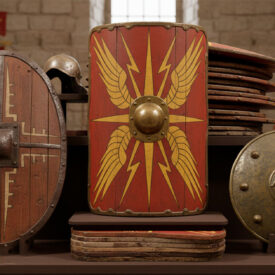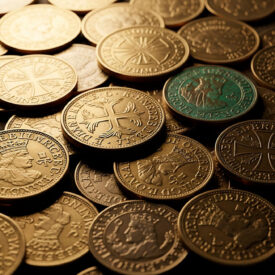The Celts were not only good warriors but also made war an art; their culture and organization into clans with a strong concept of family conditioned both their daily lives and their weaponry production. They arrived in the Iberian Peninsula around the 8th century BC, even before many Greek contacts, and where an original fusion with the Iberian peoples occurred. This mixture is especially appreciated in metallurgy: the Celtic Iron Age resulted in swords, knives, daggers, helmets, and chainmail of a high technical and aesthetic level.
Origin and Arrival in the Iberian Peninsula
The expansion of the Celtic peoples across Europe traced routes that reached the Iberian Peninsula between the 8th and 6th centuries BC. Their arrival was not a simple population movement: it was a gradual process of exchange, conflict, and cultural mixing. In the areas where they settled, the Celts introduced ironworking techniques that transformed local weapons. That is why today we can speak of a symbiotic relationship between Celts and Iberians that is reflected in archaeological pieces.
Design and Typologies of Celtic Swords
Celtic swords are recognized for their variety of shapes, sizes, and ornamental details. Two typologies stand out for their historical and archaeological significance: antenna swords and La Tène type swords. Both transmit information about forging techniques, aesthetics, and use in battle.
Antenna Swords
Antenna swords are famous for their hilt with antenna-shaped terminals or curved handles emerging from the guard. They were long and heavy; Celtic warriors carried them with pride because they combined balance, power, and ceremonial appearance. The pommels could be anthropomorphic and received gold leaf or inlays of amber, ivory, or other precious materials. The scabbards were worked with engravings and geometric or zoomorphic motifs that turned them into pieces of art as well as tools of war.
La Tène: The Emblematic Sword
The La Tène style, associated with a later stage of Celtic art, produced double-edged swords with straight blades between 60 and 90 cm. They were heavy and powerful weapons; their use spread throughout Gaul and large areas of the Iberian world, especially in the northeast. The Romans, aware of the effectiveness of these blades, feared the open wounds they produced; classical descriptions reveal horror and respect for their use.
Comparison: Types, Measurements, and Uses
| Type | Approximate Length | Weight | Use |
|---|---|---|---|
| Antenna sword | 70–85 cm | Heavy (1–1.5 kg) | Powerful cut and visual demoralization |
| La Tène (double-edged) | 60–90 cm | 1–1.6 kg | Powerful cut and thrust |
| Short swords/daggers | 20–50 cm | Light | Close combat, rituals |
Manufacturing: Materials and Techniques
Celtic mastery in iron manipulation made a key difference. They forged blades with rudimentary alloys and heat treatments that increased hardness without compromising flexibility. Hilts and scabbards integrated wood, leather, and precious metals. Ornamentation was not only aesthetic: it indicated status, ceremonial function, or clan identification.
Forging Processes
Production went through stages: wire drawing and iron forging, blade finishing, heat tempering and controlled cooling, and finishing with filing and polishing. Although modern processes did not exist, repetition and manual skill produced pieces with an excellent weight-to-strength ratio.
Decoration and Symbolism
The use of inlays, engravings, and noble metals had a dual function: to reinforce the bearer’s authority and to create objects for rituals or diplomatic exchanges. Geometric motifs, spirals, and anthropomorphic figures appear repeatedly on scabbards and pommels.
Use in Combat and Associated Techniques
Celtic swords were not limited to striking; they were part of a tactical set that included shields, spears, and shock formations. The length and weight of the sword determined the style: long blades for sweeps and frontal cuts; shorter pieces for actions in confined terrain.
Classical sources describe light infantry formations and individual warriors famous for their bravery. The aesthetics of the weapon also played a psychological role: a decorated sword intimidated and legitimized the warrior before allies and enemies.
Conservation, Finds, and Collecting
Today, many Celtic swords are preserved in museums or private collections. Archaeological finds allow us to reconstruct techniques and styles, but they also show challenges: corrosion and deterioration change the original appearance. Conservation requires specialized intervention to stabilize the metal and preserve fragile inlays.
For collectors, there are three main avenues: acquiring hand-forged replicas, reproducing historical pieces with modern materials, or seeking restored archaeological pieces (the latter only for institutions and experts). Each option requires knowing the provenance, materials, and the seller’s catalog.
Practical Tips for Conservation
- Storage: dry environments, humidity control, and avoid contact with acidic materials.
- Cleaning: specific products for metals; avoid aggressive abrasives.
- Display: padded supports that distribute weight and avoid stress points.
Where and How to Buy Celtic Swords
If you decide to buy a Celtic sword, the safest option for enthusiasts and collectors is to acquire certified pieces with a guarantee. For retail options and quality replicas, consult our official store: Medieval-Shop
When choosing a sword, check:
- Measurements and weight to ensure they fit your desired use (exhibition versus historical practice).
- Material and forging procedure (carbon steel, heat treatments, welding).
- Documentation and return and shipping policies.
Remember that authenticity has historical and economic value; archaeological pieces are not usually freely traded without permits. For recreation or private collection purposes, high-quality replicas offer an affordable and safe alternative.
The Celtic Legacy Forged in Steel
Celtic swords, more than simple weapons, are a bridge to the past. From influencing art and literature to inspiring collectors and artisans today, their legacy endures. Through faithful reproductions, museum exhibitions, and cultural festivals, these iconic pieces continue to teach us about a civilization that combined military strength, artistic expression, and a deep worldview.
11. The study of these swords continues to reveal fascinating details about the lives of the Celts. They are a tangible reminder of their ingenuity and history, reaffirming their place as one of the most important artifacts of pre-Roman Europe.











